|
Eight hours
flight from
British airports, strategically sited at the
entrance to the Persian Gulf, Oman also looks out on the Arabian Sea. Oman, with
more than 1,000 miles of pristine coastline, The Sultanate of Oman is a
country of amazing scenic contrasts.
Oman
offers visitors
wide ranging terrain from striking deserts where
camels and jeeps race along silky sand dunes to tropical seaside resorts
with palm trees and world class diving. Long sandy beaches lapped by the
emerald Arabian seas with the backdrop of rugged seemingly impenetrable
mountain ranges on which are perched historic impregnable forts.
The oldest of kingdoms,
the newest of destinations a visit to Oman can combine country markets where
farmers, silversmiths and craftsmen haggle over varieties of incense and
intricately worked silver daggers and jewellery with concerts of the Omani
Philharmonic in Muscat.
|
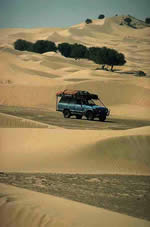 |
| (1) MUSCAT |
| The capital city of
Muscat, a city of over 500,000 is encircled by mountains overlooking the
sea. Muscat is breathtakingly situated. Old and new blend, and no
skyscrapers mar the view of its quaint harbor or the mountains. The modern
roads, landscaped with native plants, are spotless. SEE
CITY TOUR OF MUSCAT |
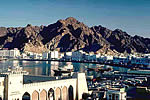 |
| FORTS |
|
Hundreds of huge forts dot
Oman. Built centuries ago, these exciting forts in Oman loom up from the
desert sands all across this country. Many of their original cannons,
muskets, brass artifacts and secret passageways are still preserved, just as
they were in the glory days of Oman. Museums aside, few historical
edifices showcase Omani martial skills and the grandeur of Omani
fortifications in times bygone like Al Jalali Fort in MUSCAT |
 |
|
Fewer still offer such a
wealth of insights into Oman's rich heritage and culture like this splendid
edifice standing sentry-like over Muscat bay. Al Jalali Fort is now a grand
museum set in an authentic, but grandiose ambience, befitting such visitors
like royalty, heads of state and other foreign dignitaries.
A heavy, gold-lined visitor
book maintained at the fort records the visits of eminent personalities and
their impressions of this great structure. Indeed, Al Jalali Fort, is
perhaps the finest of Omani historical fortifications in the capital area of
Muscat. From its vantage position atop a rocky outcrop, the fort commands
unparalleled views of the harbour and the old city, including Muscat's most
prestigious landmark which is the Al Alam palace of His Majesty the Sultan. Originally built by
Portuguese occupying forces in the early part of the 16th century, Al Jalali
Fort went through a series of transformations in design and fortification.
According to published accounts, the original structure was just a
functional fortification built into the side of the outcrop on which it
currently stands. It was hastily built partly because of persistent threats
from Persian naval forces seeking to dislodge the Portuguese from their
stronghold in Muscat. |
 |
 |
|
Towards the latter half of
the 16th century, new fortifications and towers were added. But, upon the
edifice's capture by victorious Omani forces in 1650, Al Jalali Fort was
gradually rebuilt and strengthened to take its present form. Some Portuguese
inscriptions, among a few other features, are the only vestigial traces of
Portuguese involvement in the fort. Painstaking restoration work initiated
after His Majesty Sultan Qaboos assumed power has since endowed the fort
with its present grandeur.
Together with its 'twin' —
the Mirani fort, perilously straddling another rocky outcrop just a stone's
throw away — the Al Jalali Fort once served as a bastion against foreign
seaborne aggression in its heyday. The so-called twin forts, in conjunction
with the veritable defences of the Muttrah fort and a host of fortified
structures and watchtowers along the rocky ridges of the bay, made Muscat
virtually impregnable. They collectively supplemented the old city's natural
defences offered by the massed rows of rocky hills fringing the bay.
|
 |
 |
|
Al Jalali's invincible
character is partly accentuated by the formidable wall that skirts the
perimeter of the edifice. Access is possible only from the harbour side, by
a flight of steep, rocky steps leading into the heart of the fort. A giant
inscription in Arabic, at the foot of the stairs, bears the legend 'Al
Jalali Fort, Built 1587'. (An improvised cable car now facilitates the
transfer of men and material into the fort.) Once inside, the fort's
grandiose ambience is revealed in full measure. From the terraces and the
towers, there are stunning vistas of Muscat bay and the old city including
Mirani fort and His Majesty's Palace.
Ceremonial weapons, khanjars,
traditional household utensils, incense burners and coffeepots are among the
items on display at Fort Al Jalali's museum The waters around are a
glorious turquoise while a small stretch of private beach adjoining the fort
attracts sea birds. On a rocky outcrop facing the fort are scrawled the
names of ships that called at Muscat down the ages — testimony of the port's
importance in maritime history. Only the intrepid could have scaled the
sheer faces of the outcrop to record for posterity his ship's visit to
Muscat. Among Al Jalali Fort’s most interesting facets is a cavernous
enclosure that once served as the edifice's bulwark against seaborne attack.
It overlooks the expanse of the harbour, bringing within its purview every
manner of enemy craft. |
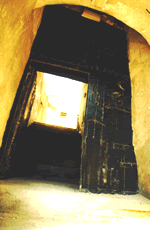 |
|
Much of the formidable firepower
of that era has been preserved as part of the fort's martial heritage — a
battery of cannons on sturdy mounts peering through gun ports, complete with
cannon shot, tow ropes and implements used to fire the guns. Ancient muskets
and matchlocks adorn the walls, as well as maps and illustrations that offer
a rare insight into maritime life before the advent of modern shipping and
navigation. Also on display is a rare illustration depicting Portuguese
possessions in Muscat. |
 |
|
There is also a valuable artist's
rendition of the port of Mombasa and other erstwhile Omani possessions in
East Africa. Another wall plaque charts wind and water currents in Muscat
bay, which was once vital for navigation within the harbour. The array of
illustrations, in fact, opens a fascinating window on life in Muscat in
pre-modern times.Right in the heart of the fort is a multi-tiered courtyard,
mellowing the otherwise menacing ambience of the structure. Many bedam and
sidr trees grow here, while an improvised falaj runs through the courtyard,
gurgling with the goodness of water. |
 |
|
Heavy wooden doors with iron
spikes bar access to strategic parts of the fort, aimed at impeding the
progress of the enemy through the gauntlet of other defences. Also in the
fort is a well-preserved room bristling with beautiful specimens of ancient
Omani culture and heritage. The room features a palm-log ceiling and
inscriptions on the walls. Notable among the items on display here are a
pair of royal wooden slippers with silver studs, and an authentic animal
skin water-carrier.One memorable highlight of the fort is its splendid
dining hall overlooking the courtyard. Up to six dignitaries can dine in
royal style around a huge, intricately carved Arabic foodtray. |
 |
|
Al-Mirani Fort, MUSCAT
Breathtaking views of the
harbour from the summit of Mirani fort
Their harbour-front location,
together with the Palace and other historical landmarks of Muscat's old
quarter, seem like elements from a picture postcard. Also called the
'Western Fort', Mirani soars a notch above Al Jalali fort, towering above
the surrounding landscape. From its pinnacle, there are breathtaking views
of the harbour, as well as the entire old city in the protective embrace of
the surrounding mountains. Barring a few watchtowers atop
their craggy summits, no other man-made structure appears to soar higher
than the Mirani. Like Al Jalali fort, the present Mirani edifice was built
on the ruins of an Omani fortification. Following the Portuguese conquest of
Muscat in the 15th and 16th centuries, the structure was bolstered in tune
with advances in military warfare of those times, especially in cannon
warfare.
Like the grandiose Al Jalali
fort, astride a rocky pinnacle in historic Muscat, its twin — the Mirani
fort — is no less magnificent. Flanking His Majesty the Sultan's Al Alam
Palace, these splendid edifices once served as bastions in the defence of
Muscat harbour and the old city. Now, proud monuments of that glorious era
of Omani gallantry and its martial heritage, the twin forts are a singular
tourist attraction as well.
Ancient wooden doors, studded
with iron spikes, can still be found inside the fort |
 |
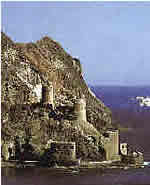 |
| |
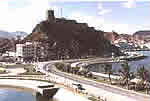 |
|
Like the grandiose Al Jalali
fort, astride a rocky pinnacle in historic Muscat, its twin — the Mirani
fort — is no less magnificent. Flanking His Majesty the Sultan's Al Alam
Palace, these splendid edifices once served as bastions in the defence of
Muscat harbour and the old city. Now, proud monuments of that glorious era
of Omani gallantry and its martial heritage, the twin forts are a singular
tourist attraction as well.
Ancient wooden doors, studded
with iron spikes, can still be found inside the fort |
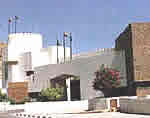 |
|
A plethora of cannon was added to
the edifice's defences which, together with those at the nearby Al Jalali
fort, made Muscat virtually impregnable in the face of any naval attack. The
structure was eventually recaptured by the intrepid Sultan Turki bin Said
after a ferocious battle, which also saw the fall of Fort Al Jalali and Fort
Muttrah back into Omani hands.Mirani has been restored to its original
majesticity as part of a concerted renovation programme initiated by His
Majesty Sultan Qaboos. On a moonlit night, the spotlighted citadel has the
ambience of a fairy-tale castle. On the inside however, parts of the fort
have made way for some amenities of modern living, yet retaining overall,
the atmosphere of an ancient fortification. |
 |
|
A formidable wall almost a
metre thick runs around the fort, supplementing the natural defences offered
by the rocky outcrop on which it stands.In fact, the structure was built
along the contours of the outcrop, with the main fortification resting on
the summit of the outcrop. Like Al Jalali fort, Mirani too has myriad rooms
and a maze of stairways, all aimed at confounding the enemy if the initial
defences were breached. For the first-time visitor, the fort can be as
perplexing and intriguing as a rabbit's warren.One key feature of Mirani is
a giant tower quite distinct from the main structure that telescopes
skywards.
Access into the fort is
either by a spiral stairway leading to various levels, or an electric
elevator. There are two circular towers at the diagonal ends of the fort,
both at different heights. Another tower, almost semi-circular in shape,
rises above the rest of the fort and dominates the surrounding landscape.
From here, there are delectable views of the waterfront with the ships
either at anchorage on steaming out on the horizon.
|
 |
 |
|
Modern interiors in a section
of the fort
Ancient passageway leading
out of the fort Facing the fort is the famous rocky landmark adjoining Al
Jalali fort, on which are chronicled the names of ships that called at
Muscat harbour down the ages. The tiny stretch of water separating Mirani
and the rocky mass is perhaps the most alluring along Muscat's coastal
front. Although off bounds to fishing and swimming because of its sensitive
location, the turquoise waters are rich in marine life.
A tiny circular room on the
topmost floor of the tower now serves as a museum for the fort's heritage
and past glory. On top of the arched doorway to the museum is a Portuguese
inscription which, perhaps, is the only evidence of that era. |
|
Inside are some fine relics of
Omani history and its martial heritage. There is a 17th century Omani sword,
which is said to cut sharply when vibrated, besides an English-made Martin
Henry gun of 1871-vintage. Also on display is an Omani wick gun of 18th
century vintage, found in Nizwa, and an English-made double-barrel shotgun
dating back to 1864.Preserved in glass showcases is a variety of Omani
silver jewellery like brooches, necklaces, amulets and anklets, including a
finely designed Mazrad or necklace lined with Maria Theresa coins which were
in currency then. |
 |
|
(2)
NIZWA FORT AND AL JABAL AL AKHDAR GREEN MOUNTAINS |
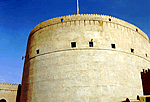 |
|
The oasis city of Nizwa, the largest
in the interior province, was the capital of Oman in the 6th and 7th
centuries. Nizwa is located
in the heart of Oman about 165 km from Muscat the capital city. Driving is
about an hour and a half, the road pass through many Wilayats like Bidbid,
Samail, and Izki. Today it remains one of
the most popular tourist attractions with its historical buildings and
imposing fort built in the mid 17th century by Imam Sultan Bin Saif Al
Ya'ribi, The town's immense palm oasis stretches for eight kilometers along
the course of two wadis. It is famous for its bustling souq where tourists
can buy exquisite copper and silver jewellery and other craft items.
SEE NIZWA FORT
TOUR |
 |
|
The magnificent Nizwa Fort is a wonder on its own. Nizwa fort reflects the military
engineering prowess of fort-builders of a bygone time. It is also one of the
Sultanate's finest historical edifices, attracting great numbers of tourists
each yearNizwa old and new souqs (markets) provide the visitor with all his
or her needs with many choices to select from, |
 |
|
The Rocky Mountains
"Jebal alHajar" form the background to Nizwa. From Nizwa you get to visit Al-Jabal
Al-Akhdar and Al-Misfat which are 3000m or 10000 feet above sea level. Here
are the most spectacular mountain area of Oman.
Oman
most spectacular areas. Up in the mountains, calm summers provide the
visitor with a unique fresh air surrounded by breathtaking stones, natural
architecture and temperate-zone trees and shrubs. Besides, there are the
palm oasis on Wadi (valley) Kalbouh and Al Abiadh from Birkat Almouz to
Tanuf, just something you will always feel in need to visit again and again. |
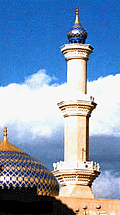 |
|
WHERE TO GO FROM NIZWA: |
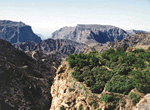 |
|
You may consider Tanuf.
Waterfalls in Tanuf are unique to the area within the steep mountain sides
and the water reservoir, you may want to spend a picnic day. All facilities
are available and I am sure you will enjoy it there. From there you can go
to Al-Hamra. Wilayat Al-Hamra is another tourist attractive town that you do
not want to miss when you visit the interior. Towers and ancient forts are
scattered in every village and farms all around with a countryside life
style. Two major locations are of great interest to all Al-Hamra visitors,
these are Al-Mesfah and Jabal Shams. You need a 4-Wheel drive to climb 3000m
above sea level for a different type of climate and a totally new and
non-spoiled regions. Al-Hamra old market worth the visit plus other parks
and tourist attractions. You may also want to head to the villages of Al-Qala'a,
Al-Qaryah or Al-Aredh. All neat locations that observe the Omani traditions.
From Nizwa you can go to Bahla where Oman ancient pottery is still alive.
|
 |
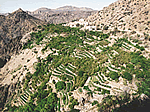 |
| AL JABAL AL AKHDAR GREEN MOUNTAINS |
 |
|
BEGINNING from Bid Bid, the road to the historic city
of Nizwa looks more and more like an intestine coursing its way within the
bowels of a range of mountains flanking both sides of the highway. Just a few kilometres before the heart of Nizwa,
one of those mountains rises to a dizzying height. At about ten thousand
feet above sea level, Al Jabal al Akhdar (The Green Mountain) is undoubtedly
one of the highest points in the Sultanate, making it a hotspot for the
adventurous.
But Al Jabal al Akhdar is not just another geological
curiosity or challenge waitingto be unraveled.
One of the protected areas in
the Sultanate of Oman, the Green Mountain is inhabited by many nuclear communities sprinkled over different levels on the mountain |
|
 |
 |
|
In contrast to the hot humid summer
days of the coast, the climate of the mountains is cool and temperate.
In winter the temperature can plunge below 5 degrees Centigrade. There is a
gowing
feeling of being in an entirely different world from the coastal areas, a
difference that became even more pronounced as visitors make their winding way up to crest of the mountain
past scenic mountaintop hamlets on Al Jabal al Akhdar
|
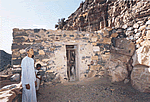 |
|
At the base of the Green
mountain, the visitor may wonder why it was called the Green Mountain, for the
surroundings are typically semi-arid features, largely rocky terrain and
dusty soil. The reason is that at the
higher planes of the mountain, scattered over the area are vegetations
comprising fruit trees, flowers and shrubs. Al Jabal al Akhdar receives
an average of 303mm of rainfall in a year. Coupled with its cool climate, it
is therefore a friendly turf for these plants. Communities such as Wadi Bani Habib, Saiq, Al Manakher,
Al Ain, Kotom al Hail and Al Shuraijah have clusters of farms growing
pomegranates, apricots, peaches, cherries and walnuts.
|
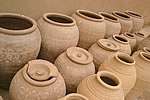 |
|
One of the alluring sights on the Jabal is the
glistening water cascading down the rocky mountain against a sunny backdrop.
In one area alone, Ain Wadi Kotom, there are more than 10 major springs. These springs are the main source of water supply for
the communities, especially those at the higher planes on the mountain. The
entire breadth of the area is linked with a network of Aflaj which hold the
water and deliver it, as it were, to the doorsteps of the residents.
Another highly prominent feature of the mountain
connected with water is the wadi. Al Jabal al Akhdar has not less than 300
wadis and streams most of which extend further down into the wadis of Nizwa
and neighbouring areas like Izki and Al Awabi. |
 |
| (4) WADIS AND WADI BANI AUF,
SNAKE GORGE |
|
|
Stunning gorges and scenic mountain hamlets are part of
the Green Mountain’s tourist charms. The Sultanate draws much of its
character from its great wadis which, like arterial lifelines criss-cross
the length and breadth of the country, spawning a multitude of streams and
springs that in turn support Oman's enchanting heritage of verdant oasis
villages. These wadis boast their own distinctive appeal as they meander
through mountains, valleys and plains
Deep within the recesses of
these mountains strung along the Rostaq-Nakhl route is Wadi Bani Auf,
an ancient wadi offering breathtaking vistas along its 26-kilometre trail. A
trek through Wadi Bimah, also called Snake Gorge, is the highpoint of
a tour of picturesque Wadi Bani Auf in Al Rostaq wilayat. Warm Snake Gorge is not for the squeamish
at heart. Dark legends surround this great fissure in the rugged landscapes
of Al Rostaq — about water-filled caves that can only be traversed by
swimming underwater for a considerable distance; about death-defying leaps
from 10,000-feet cliffs into pools of water just two feet deep, and so on.
But, fortunately, these
stories hold no truth.It is true, nevertheless, that the wadi — like any
other wadi in the country — can be transformed into a dangerous torrent in
the aftermath of a downpour.
The rains, and the inevitable
floods, are in fact vital to replenish the aquifers that feed aflaj and
underground spring in the wadi. Yet, at times, they can also be the bane of
these villages. Sometimes, the flooding is so severe that date trees and
crops get destroyed. After a heavy downpour, the wadi is in spate for at
least 10-12 hours. The roaring wadi then turns into a gentle stream, with
cool, crystal-clear water, which flows for about 10 days thereafter. As a
precaution, local villagers now grow their crops and date trees
terraced-fashion along the higher elevations of the wadi. |
 |
 |
| |
 |
| |
|
| (5) DHOFAR AND COASTAL AREAS |
|
|
OF all the coastal areas in Oman, the Governorate of
Dhofar’s 800-km-long coastline stands out as an area of diverse and special
environments. Good environmental quality is a prerequisite for the health
and well-being of human beings, plants and animals and for sustainable
development.
In order to meet the challenges of environment and
development, Oman has worked out a comprehensive Coastal Zone Management
Plan for the Governorate of Dhofar in consultation with World Conservation
Union.
Aimed at preserving and, where necessary, restoring the
natural richness, variety, and quality of the coastal environment, the plan
is expected to be implemented more vigorously during the on-going Year of
Environment.
Stretching from Wadi Haytam to Yemen, the Governorate
of Dhofar’s coastal zone offers strikingly beautiful and diverse scenic
views. |
 |
|
|
|
|
The cliffed, rocky and sandy shores, small rocky
islets, and the Al Halaniyat Islands — the largest group of offshore islands
in Oman — lend a new charm to the wild rugged beauty of the Dhofar coastline
coastline.
Long sweeps of pristine beaches add another dimension
of beauty to much of Governorate of Dhofar’s coast.
Cliffed shores from Sawqirah to Sharbitthat offer a
unique contact with nature. Because most of the cliffs are bordered by the
seas deeper than six metres with scattered rocky reefs, tourists have a
penchant for this area, according to Coastal Zone Management Plan of
Governorate of Dhofar drafted by World Conservation Union (IUCN). |
 |
|
|
|
|
|
|
The coastal
scenery of Governorate of Dhofar is unique and holds out a tremendous
potential for nature tourism. Residents of Salalah, as well as visitors from
Gulf states, who picnic along the coast or simply visit scenic areas to
enjoy the view, greatly appreciate the coastal scenery |
 |
|
Rocky reefs fringe most of the Governorate of Dhofar
coast, and harbour coral communities. Abundant growth of corals in the
sheltered mainland coves and around Al Halaniyat Islands provides a
beautiful view with attractive and varied assemblages. Campers frequently
snorkel and dive over the coral reefs in the Raaha area. |
|
The Khawr environments of Governorate of Dhofar,
supporting thousands of migrating seabirds, flamingoes and shorebirds, offer
unforgettable sights, say tourists.
Dhofar’s stunning natural beauty gives it an enduring
appeal
Mangroves in nine Khawr sites on the Salalah plain not
only support a great range of animal species, from worms and crabs to fishes
and birds, but also transform the more saline khawr environment into highly
productive and green habitats.
|
| (6) AL HALANIYAT ISLANDS |
|
|
The Al
Halaniyat Islands, especially valuable nesting grounds for loggerhead
turtles, are a hub of tourists in May-June, the peak nesting period. |
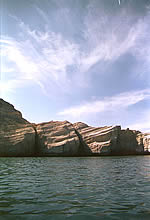 |
|
Green turtles nest in varying numbers on some 135
beaches along the mainland coast from Wadi Haytam to west of Rakhyut, and
the Al Halaniyat Islands. The tourists visit this area in April when turtles
begin nesting in low numbers and continue through into December at some
locations.
The peak
nesting period of July-August attracts largest number of visitors.
Loggerhead turtles nest in the greatest numbers and on 152 beaches, says the
IUCN report |
|
Among the environmental concerns in the Al Halaniyat
Islands is the ever-present threat of major oil pollution, says the IUCN
report.
Seabirds and shorebirds found along the entire coast
showcase nature’s beauty. The Al Halaniyat Islands, where thousands of
gulls, boobies and cormorants nest, are areas of exceptional importance to
coastal birds.
Offshore waters provide rich feeding grounds for
nesting seabirds and non-breeding visitors, including petrels from the
Southern Hemisphere. While Governorate of Dhofar abounds in coastal and
marine resources, some areas stand out as special environments with unique
and enchanting charms of their own.
South Jazir Coast, a long beach backed by low dunes and
wide coastal plain, with a large barrier lagoon, is one of the best examples
in of its kind in Oman.
Harbouring the greatest number and variety of migrant
seabirds and waders in winter months, South Jazir Coast is also known for
vast tidal flats, algal beds, turtle feeding grounds and several khawr areas
that offer feeding grounds for waterbirds. |
 |
|
Ra’s Nuss, a scenic coast with sculptured granite
outcrops, rocky reefs, turtle nesting and feeding grounds, and important
spiny lobster including a lobster breeding site,
offers spectacular views. |
|
|
|
|
|
Sur is probably the most
famous costal town in Oman. It is situated approx 230 km South of Muscat. It
used to be a major trading port with Mombasa and Zanzibar in East Africa.
You can still see craftsmen building fishing dhows in the shipyards. The
larger ocean going dhows which where famous in 19th century have since
declined due competition from larger & fatser cargo ships. A trip to Sur is
a must for anyone visiting Oman and could be combined with a trip to Turtle
Beach. You can get to Sur on the main blacktop road from Muscat or why not
try the scenic costal route in your 4 wheel drive |
|
| |
|
| |
|
| |
|









































